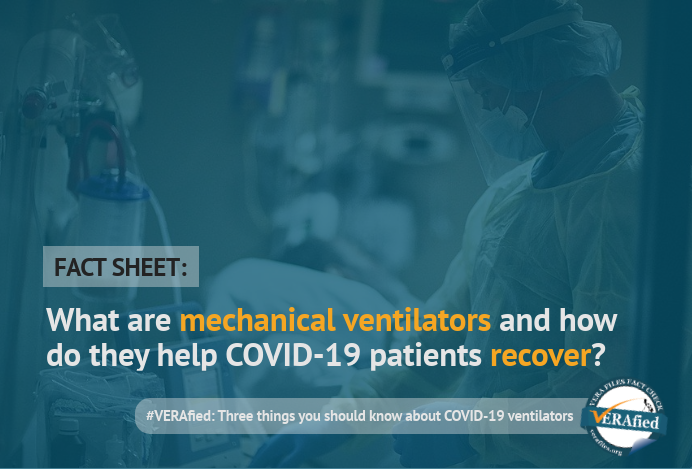Although no cure has yet been proven to contain the coronavirus disease (COVID-19) pandemic, the number of recorded patients in the country who have recovered from the disease has steadily risen since mid-April, according to data from the Department of Health (DOH).
As of June 22, the DOH COVID-19 Bulletin showed a total of 21,362 active cases. Of these admitted patients, 67 were severe cases, or patients experiencing labored breathing, while 18 were in critical condition and intubated, or breathing through a tube inserted down the throat and into one’s windpipe.
COVID-19 treatment in health facilities focused on supportive care, helping patients retain vital life functions while their bodies try to recover. Many of the survivors reached the critical stage and had to be intubated and placed on mechanical ventilators to ease their breathing difficulty.
What are mechanical ventilators and how do they help COVID-19 patients recover? Here are three things you need to know:
1. What are the therapeutic benefits of ventilators to COVID-19 patients?
A form of life support, ventilators are machines used to help push air in and out of the lungs of patients whose conditions make it difficult for them to breathe on their own.
Those infected with SARS-CoV-2 — the virus that causes COVID-19 — are at risk of progressing to have respiratory complications such as pneumonia and, in more severe cases, acute respiratory distress syndrome, a form of lung failure, according to a Johns Hopkins Medicine explainer.
In such cases, a mechanical ventilator aids the patient by pushing air, which may include extra oxygen, into the airway and lungs. It may also carry carbon dioxide out of the lungs when patients breathe out.
However, the use of ventilators may also pose risks to patients. For instance, being on a ventilator can make a patient more susceptible to pneumonia, may damage one’s vocal cords or lungs, or cause other problems.
2. Who must be placed under ventilators?
COVID-19 patients requiring ventilators are those categorized with severe or critical illness, physician Faith Joan Gaerlan, training officer at the University of the Philippines – Philippine General Hospital, told VERA Files in an email.
Those who experience symptoms, including difficulty in breathing with “no improvement in work of breathing and oxygenation,” despite administration of oxygen using an “airway adjunct,” or with “altered sensorium,” pertaining to the inability to think and concentrate clearly, with decreased consciousness, may also be given the same treatment, added Gaerlan, also a member of nonprofit Medical Action Group.
She said critically ill individuals requiring mechanical ventilators are best monitored in an intensive care unit (ICU) where “equipment and human resources are best suited for the care of these patients.” She pointed out, however, that not all in the ICU are on ventilators:
“A COVID-19 patient, for example, who developed a stroke during his COVID confinement, might not have difficulty with breathing or respiratory problems but will be placed in the ICU because deterioration in neurologic function must be continuously monitored.”
Moderate cases “do not require ventilatory support” because “they can still support breathing.” There are, however, some exceptions for the elderly, immunocompromised or have unstable co-morbid conditions, which make such patients more likely to develop severe or critical form of the coronavirus infection, Gaerlan added.
Health Undersecretary Maria Rosario Vergeire, in a June 15 email to VERA Files, said the time span of patients being put under mechanical ventilation “depends on many factors” such as “medications and nutritional status of patients.” She added that there is “no definite time period” for administering such treatment to individuals.
Further, the “survivability of COVID-19 patients” placed on mechanical ventilation may also rely upon clinical factors such as bacterial co-infection, nutritional status, age, and comorbid disease, Vergeire said.
Ventilators will not cure COVID-19 or other illnesses. Rather, they just provide supportive care to patients, and may be disconnected once they begin breathing properly on their own.
Mechanical ventilators are often reused for other patients after proper sanitization and disinfection. They can also be maintained and repaired to serve for an extended time, Vergeire added.
3. Do we have enough ventilators?
The DOH tracker shows the country has a total of 1,996 mechanical ventilators dedicated exclusively for COVID-19 patients as of June 23, based on data from 1,913 health facilities, including public and private hospitals and medical clinics, nationwide. DOH’s DataCollect App shows 406 or 20.34 percent of these are currently in use, while 1,590 or 79.66 percent are on standby.
To prevent the spread of the virus, a room can accommodate only one COVID-19 patient at a time, and no two patients are allowed to share ventilators and other life-support equipment, according to physician Norberto Francisco, spokesperson of the Lung Center of the Philippines, a COVID-19 referral hospital in Quezon City. This, Francisco told VERA Files in an April 16 interview, linked ventilator demand to the number of occupied ICU beds.
DOH data as of June 23 showed there are 1,314 ICU beds in the Philippines dedicated to COVID-19 patients: 473, or 36 percent, are occupied, while 841, or 64 percent, are vacant.
In a Laging Handa briefing on May 27, Vergeire said the country’s current occupancy rate in hospitals relative to the number of cases shows “good indication” in its health capacity, noting that ICUs and mechanical ventilators are “not maxed out” with the country’s 1,303 ICU beds (38.40 percent of which were occupied) and 1,961 ventilators (19 percent in use) at the time.
On April 13, DOH noted a shortage of supply in personal protective equipment, ventilators, and respirators — with only 1,236 ventilators available nationwide as of April 1.
The department called on local establishments to manufacture such equipment without having to secure a Certificate of Product Notification or Registration in view of the state of public health emergency. Manufacturers, however, still need to secure a license to operate from the Food and Drug Administration before they can start production.
The Department of Science and Technology has developed a locally-designed portable ventilator called Ginhawa (ReliefVent), which is currently producing prototypes.
Sources
Department of Health, COVID-19 Tracker, Retrieved on June 23, 2020
Department of Health Facebook, COVID-19 Case Bulletin #101, June 23, 2020
Department of Health, Press Release: DOH explains COVID-19 treatment protocols, April 16, 2020
Benefits of ventilators
- National Heart, Lung, and Blood Institute, Ventilator/Ventilator Support
- American Thoracic Society, Patient Education, Information Series: Mechanical Ventilation, April 2020
- John Hopkins Medicine, What Coronavirus Does to the Lungs
Administration of ventilators
- Personal communication with Dr. Faith Joan Gaerlan, June 16, 2020
- Medical Action Group website, Retrieved on June 23, 2020
- World Health Organization, Patient triage and referral for resource-limited settings during community transmission, March 22, 2020
- Department of Health Facebook, Virtual Presser, April 16, 2020
- Department of Health, COVID-19 FAQS: Who are most likely to present with severe symptoms?, March 2, 2020
- World Health Organization, Patient triage and referral for resource-limited settings during community transmission, March 22, 2020
- Department of Health Facebook, Virtual Presser, April 16, 2020
- Department of Health, COVID-19 FAQS: Who are most likely to present with severe symptoms?, March 2, 2020
- Freedom of Information-Department of Health, COVID-19 Ventilators, June 15, 2020
Ventilators’ supply
- Personal communication with Dr. Norberto Francisco, April 16, 2020
- Presidential Communications Operations Office, Public Briefing #LagingHandaPH, May 27, 2020
- Department of Health, DOH COVID-19 Case Bulletin #074, May 27, 2020
- Department of Health, Reiteration of FDA circular on interim guidelines of PPEs, ventilators, respirators in light of COVID-19, April 13, 2020
- ABS-CBN News, UP scientists making ventilators as coronavirus cases mount: health dept, April 1, 2020
- Rappler, DOH requests purchase of P1.3 billion worth of ventilator, April 20, 2020
- Philstar, COVID-19 cases sa bansa halos 5,000 na habang gumagaling 242 pa lang, April 13, 2020
- Fortunato de la Peña Facebook, Meeting with members of the the Inter-Agency Task Force on Emerging Infectious Diseases (IATF-EID) at Malacañang Palace, April 27, 2020
- Philippine Council for Health Research and Development, Ginhawa(ReliefVent), Oct. 1, 2018
(Guided by the code of principles of the International Fact-Checking Network at Poynter, VERA Files tracks the false claims, flip-flops, misleading statements of public officials and figures, and debunks them with factual evidence. Find out more about this initiative and our methodology.)




